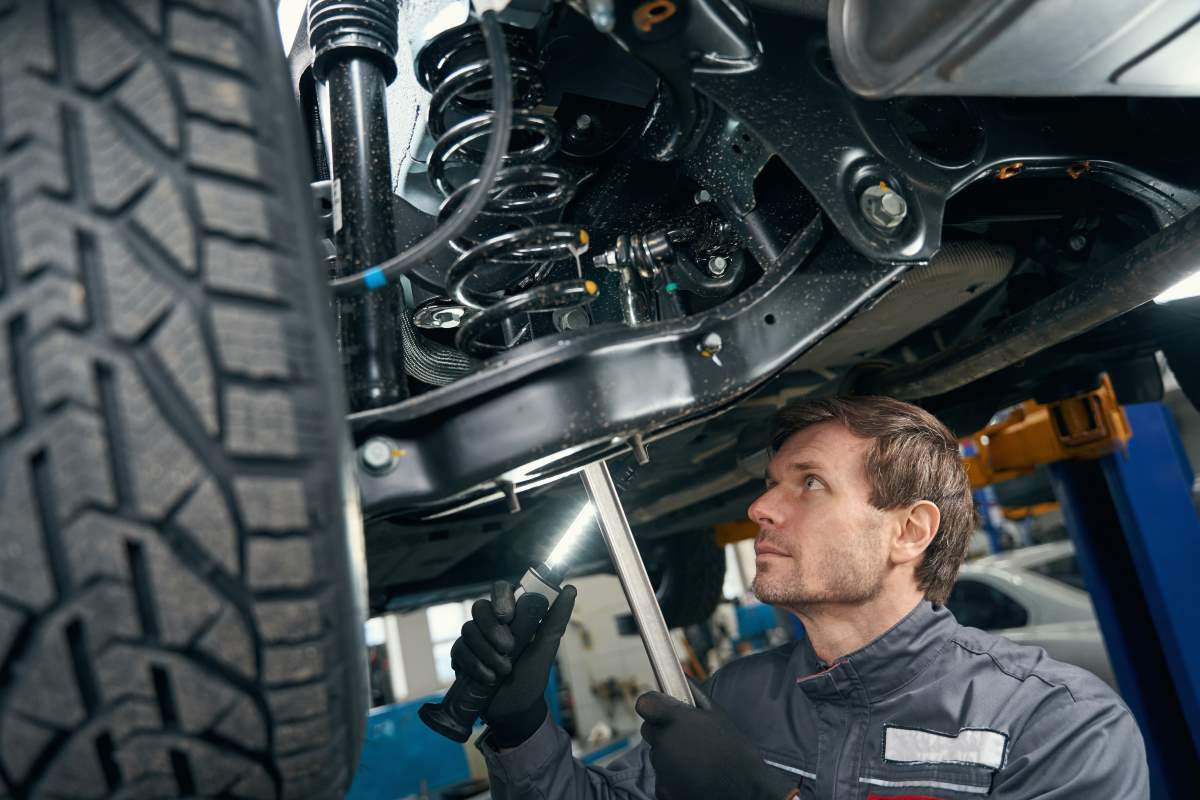9000+ Cashless Garages
96% Claims Settled (FY 24-25)

9000+ Cashless Garages
96% Claims Settled (FY 24-25)



Your car's suspension system is crucial to your daily driving experience. It keeps your ride comfortable, stable, and in control, regardless of how bumpy the road becomes. But how often do we think about it? Probably only when something feels off, like an odd noise.
The suspension system doesn't just impact comfort; it's also key to your car's safety. A problem with your suspension can affect handling and braking, and even cause uneven tyre wear. Spotting these issues early can save you from costly repairs and ensure every ride is as smooth and secure as possible.
In this guide, we'll explain everything you need to know about what is car suspension. This article covers everything from understanding its importance and spotting the signs of trouble to simple inspection tips. Ready to explore? Let's get started!


A car suspension system is a complex setup of parts that couple the vehicle's body to the wheels. It allows smooth travel and maintains contact between the tyres and the ground. The parts that make a suspension include springs, shock absorbers, and control arms that fit the wheels to the body of your car.
Their primary function is to absorb bumps and road vibrations. Suspension systems balance the car, enabling you to maintain control and comfort while driving. The suspension system achieves this while the car is braking and cornering over rough roads, enabling it to remain stable.
The suspension system will keep your vehicle safe, comfortable, and performing. A few reasons why regular maintenance is essential are as follows:
Safety: The suspension system is a key point of contact with the road, ensuring stable handling and braking. When parts are worn out, it leads to a loss of control.
Better Ride Quality: A suspension system absorbs shock and vibration from the road surface, making the ride smoother for the driver.
Tyre Wear: The suspension system ensures proper contact with the tyres on the road surface. A malfunction in the suspension system results in poor tyre wear.
Handling and Stability: Good suspension ensures the vehicle corners smoothly and remains stable overall. Worn parts will compromise these aspects.
Avoiding Costly Repairs: Regular maintenance helps identify minor problems before they escalate into major, expensive ones, thereby saving you money on costly repairs.
Several typical indicators will tell you whether you have problems with your car's suspension. The following are some of the common ones:
Routine checking of your car's suspension is essential in maintaining safe handling, a smooth ride, and ultimate performance. Here's the guide on how to inspect your car's suspension to identify problems before they become issues:
Inspect the shock absorbers, struts, and suspension components for fluid leaks. Oil leaks often indicate worn-out shocks or struts. Check the coil, leaf, and air spring. Determine cracks, breaks, or sags under load. Verify if there are cracked or torn pieces. Check control arms, ball joints and their connecting parts, as these may be corroded.
Push on each corner of the car one at a time and release. If it bounces repeatedly before settling, the shock absorbers or struts may be old and should be replaced. If the car bounces after each push, it indicates a loss of damping efficiency, and the shock absorbers or struts are likely no longer functioning properly.
Tyre wear that is inconsistent, has bald patches or is "cupping" can indicate suspension issues. Look for overwear on the inner or outer edges of tyres. This can be symptomatic of misalignment or worn suspension parts. A quick inspection of tyre wear can help you spot these suspension problems early, thereby avoiding further damage to other parts.
Take your car for a few miles and observe any tendencies to pull to one side, wandering or difficulty steering in a straight line, or wobbling. Poor ride, bouncing tendency, and leaning deeply translate as suspension defects, especially on sway bars or shock absorbers. The car could need repair when you notice uneven steering responses.
Brake hard from a slow speed. If the front end of your car drops, it indicates that the shock absorbers or struts are worn. Pulling away from a stop and the car's back end drops very low suggests that either the rear springs or shocks are weak, affecting handling and safety. These symptoms can also lead to uneven tyre wear and longer stopping distances.
Water exposure in cars poses one major problem, which is mould growth. It can cause long-term damage to the vehicle and its interiors. Here are a few measures to be taken to prevent mould formation after flooding:
Before cleaning, the most crucial point is to reduce the humidity in the vehicle to prevent mould growth in humid conditions. Open all doors and windows to allow air to circulate and speed up the drying process with fans.
Vacuum the carpet, upholstery, and mats once the car has dried to remove all dirt and debris. This removes any dead mould spores. The places you can't see are the ones behind the seats, where mould may accumulate.
Vinegar is a natural disinfectant and mould killer, so it is well-suited for cleaning surfaces that are often affected by mould. This solution should treat upholstery, fabrics, and all areas that might be infected.
Spray the vinegar solution generously over all the mouldy spots and cover thoroughly. Allow the solution to slaughter all mould spores for several minutes. Wipe away any visible mould.
If you notice any of the following signs of suspension problems, you have to visit a mechanic:
Unconventional Noises: If you experience clunking, knocking, or squeaking noises while driving over bumps or turning corners, seek professional care.
Bouncy or Jerky Ride: If your car continues to bounce much, or the ride becomes stiffer and jerkier, the chances are the shock absorbers or struts are faulty.
Pulled in One Direction: This can be an indicator of either suspension or an alignment issue that may require the attention of professional car diagnostics.
Steering Problems: Loose, hard holding, and unresponsiveness may indicate a worn-out or seized control arm or ball joint, among other issues.
Visible Damage: If you see fluid leaking from suspension components, if springs are broken, or if any part of the suspension is visibly damaged, then consult a mechanic.
Loss of Vehicle Stability: The vehicle feels unstable, especially when taking sharp turns and braking, or it tends to "nose dive" or "squat." It's time to visit a mechanic.
Suspension maintenance is crucial for maintaining your car's longevity, comfort, and safety. Here are some preventive maintenance tips to keep your suspension fit as a fiddle:
Check suspension components regularly through visual checks. This should include worn-out or damaged shock absorbers, struts, springs, and bushings. Inspect the area around shock absorbers and struts for fluid leaks.
Have your wheels aligned to prevent uneven tyre wear, which will negatively impact the suspension. Unbalanced tyres can create unnecessary stress on the suspension system.
Ensure your tyres are correctly inflated to the recommended pressure. Under or over-inflated tyres can create poor suspension performance and uneven wear.
Where possible, avoid hitting potholes, speed bumps, and other rough roads, as doing so at high speed may damage suspension parts. Slow down your speed on the bad roads.
Have your suspension system inspected by a mechanic at least once a year, or as recommended by your car manufacturer. If your suspension system starts producing noises, inspect the system right away.
Do not wait for worn-out suspension parts, such as shock absorbers, springs, or bushings, to fail. Replacing them promptly can prevent further damage to the system.
Rinse your car's undercarriage to wash away dirt, road salt, and debris that may cause corrosion or damage to suspension components, especially in winter.
The prices for repairing or replacing the suspension vary depending on the car model and purchase location. Here's a table outlining common suspension repairs and their approximate costs:
| Suspension Repair | Description | Estimated Cost (Parts & Labour) |
| Shock Absorber Replacement | Replacing the old shock absorbers for proper handling and ride comfort. | ₹15,000 - ₹30,000 per shock (depending on vehicle) |
| Strut Replacement | Replacing struts, which combine shocks and springs for stable handling in turns. | ₹25,000 - ₹55,000 per strut (depending on vehicle) |
| Spring Replacement | Replacing coil springs or leaf springs that were found sagged or broken. | ₹12,000 - ₹25,000 per spring (depending on type) |
| Ball Joint Replacement | Replacing worn-out ball joints that are key to steering and suspension alignment. | ₹15,000 - ₹30,000 per joint (labour-intensive) |
| Control Arm Replacement | Replacing damaged or worn control arms that will allow smooth movement of the wheels. | ₹15,000 - ₹40,000 per control arm (labour-intensive) |
| Tie Rod Replacement | Replacing worn tie rods that connect the steering with the suspension. | ₹12,000 - ₹30,000 per tie rod (depending on vehicle) |
| Sway Bar Link Replacement | Replacing broken sway bar links that reduce body roll in turns. | ₹8,000 - ₹20,000 per sway bar link |
| Wheel Alignment | Alignment of wheels ensures that tyre wear is even and handling remains optimum. | ₹1,500 - ₹2,500 (usually not a major repair) |
| Bushings Replacement | Replacing worn suspension bushings will reduce friction and noise. | ₹8,000 - ₹30,000 per set (depending on type) |
Note: Prices may vary depending on the car model and whether aftermarket items or OEM parts are being purchased. Whatever the case, it should be taken to a professional mechanic who knows best how much that would cost.
It is essential to check your car suspension system regularly to ensure smooth, safe, and even comfortable driving. You can catch suspension problems early and avoid costly repairs by noticing common signs of these issues. Essential inspections help identify problems before they become significant issues.